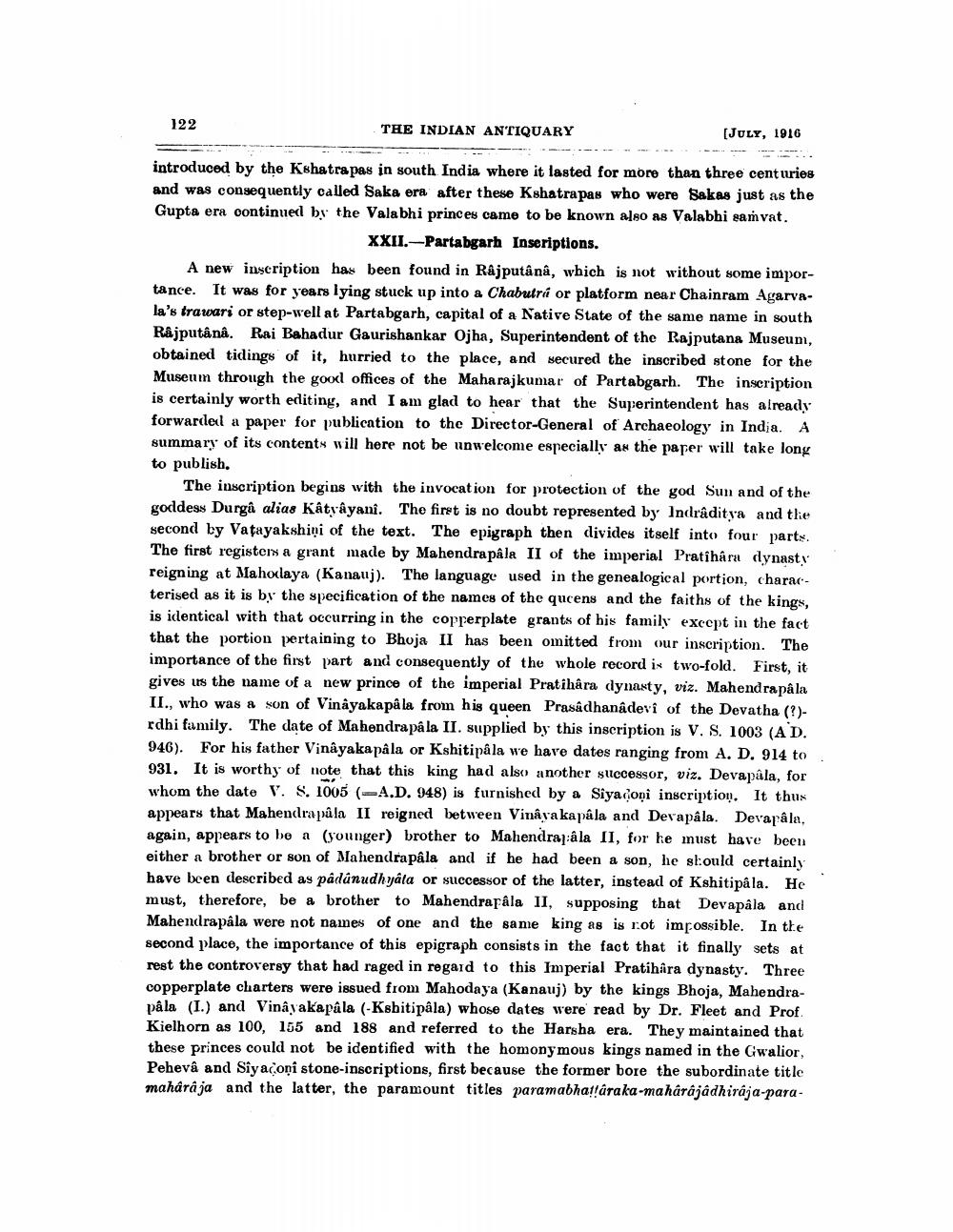________________
THE INDIAN ANTIQUARY
introduced by the Kshatrapas in south India where it lasted for more than three centuries and was consequently called Saka era after these Kshatrapas who were Sakas just as the Gupta era continued by the Valabhi princes came to be known also as Valabhi samvat.
XXII. Partabgarh Inseriptions.
A new inscription has been found in Râjputânâ, which is not without some importance. It was for years lying stuck up into a Chabutra or platform near Chainram Agarvala's trawari or step-well at Partabgarh, capital of a Native State of the same name in south Rajputânâ. Rai Bahadur Gaurishankar Ojha, Superintendent of the Rajputana Museum, obtained tidings of it, hurried to the place, and secured the inscribed stone for the Museum through the good offices of the Maharajkumar of Partabgarh. The inscription is certainly worth editing, and I am glad to hear that the Superintendent has already forwarded a paper for publication to the Director-General of Archaeology in India. A summary of its contents will here not be unwelcome especially as the paper will take long to publish.
122
[JULY, 1916
The inscription begins with the invocation for protection of the god Sun and of the goddess Durgâ alias Katyayani. The first is no doubt represented by Indrâditya and the second by Vatayakshini of the text. The epigraph then divides itself into four parts. The first registers a grant made by Mahendrapâla II of the imperial Pratîhâra dynasty reigning at Mahodaya (Kanauj). The language used in the genealogical portion, characterised as it is by the specification of the names of the queens and the faiths of the kings, is identical with that occurring in the copperplate grants of his family except in the fact that the portion pertaining to Bhoja II has been omitted from our inscription. The importance of the first part and consequently of the whole record is two-fold. First, it gives us the name of a new prince of the imperial Pratihâra dynasty, viz. Mahendrapâla II., who was a son of Vinayakapâla from his queen Prasâdhanâdevi of the Devatha (?)rdhi family. The date of Mahendrapâla II. supplied by this inscription is V. S. 1003 (AD. 946). For his father Vinayakapâla or Kshitipâla we have dates ranging from A. D. 914 to 931. It is worthy of note that this king had also another successor, viz. Devapâla, for whom the date V. S. 1005 (A.D. 948) is furnished by a Siyadoni inscription. It thus appears that Mahendra pâla II reigned between Vinayakapâla and Devapâla. Devapâla, again, appears to be a (younger) brother to Mahendraj:âla II, for he must have been either a brother or son of Mahendrapâla and if he had been a son, he should certainly have been described as pâdânudhyala or successor of the latter, instead of Kshitipâla. He must, therefore, be a brother to Mahendrapâla II, supposing that Devapâla and Mahendrapâla were not names of one and the same king as is not impossible. In the second place, the importance of this epigraph consists in the fact that it finally sets at rest the controversy that had raged in regard to this Imperial Pratihara dynasty. Three copperplate charters were issued from Mahodaya (Kanauj) by the kings Bhoja, Mahendrapâla (I.) and Vinayakapâla (-Kshitipâla) whose dates were read by Dr. Fleet and Prof. Kielhorn as 100, 155 and 188 and referred to the Harsha era. They maintained that these princes could not be identified with the homonymous kings named in the Gwalior, Pehevâ and Siyaconi stone-inscriptions, first because the former bore the subordinate title maharaja and the latter, the paramount titles paramabhaṭṭaraka-mahârâjâdhiraja-para




